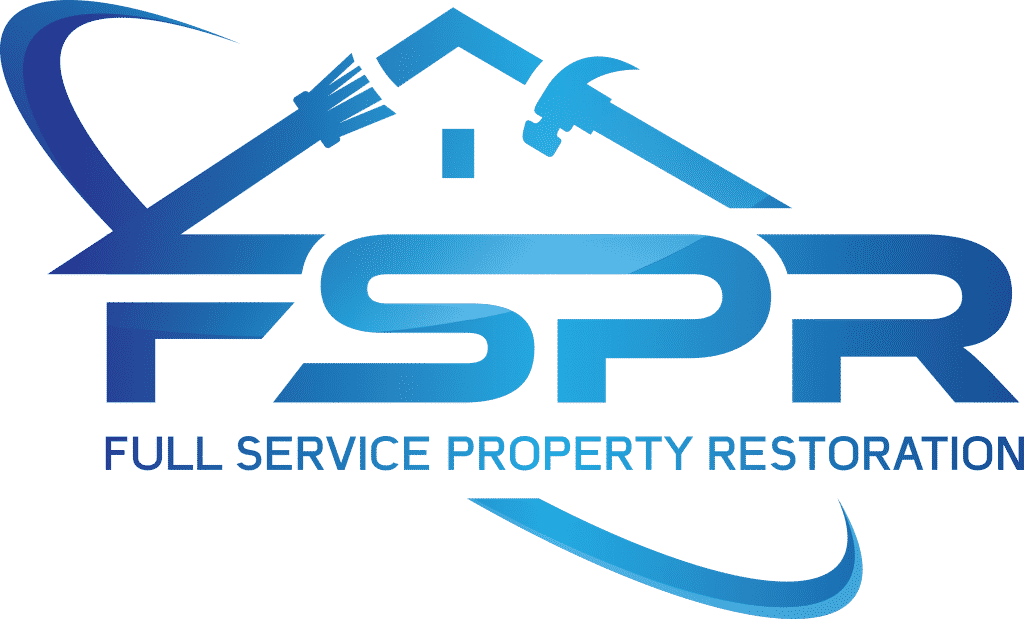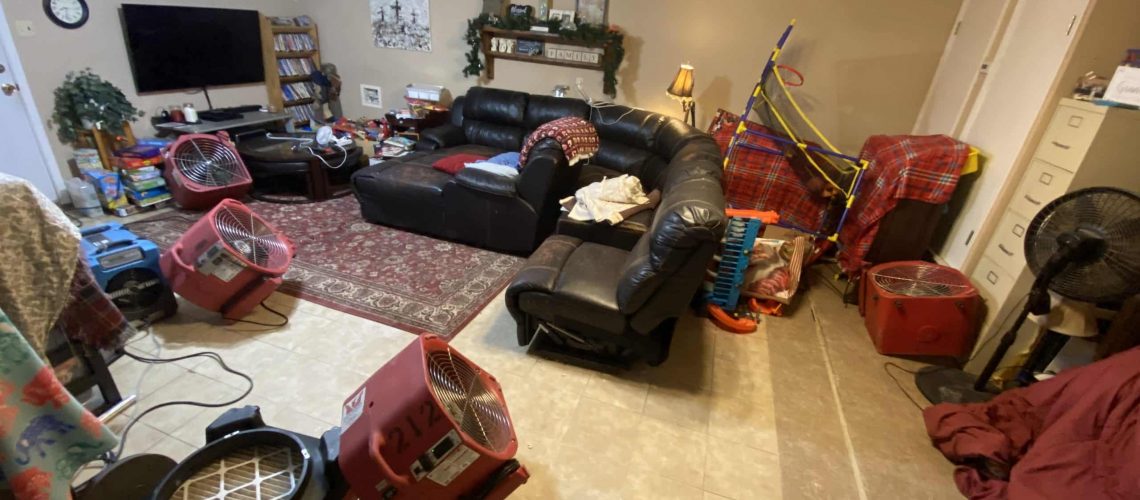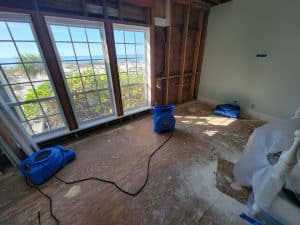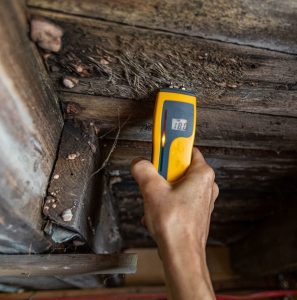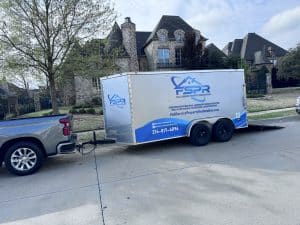When water damage strikes your home or business, it’s easy to start panicking. When a pipe bursts, a storm hits, or an appliance malfunctions, water intrusion is devastating. But before you dive into action, it’s important to understand that what you don’t do after water damage can be just as important as what you do.
Over the years, we’ve seen some common mistakes that can delay recovery, increase costs, or even put people in harm’s way, but we have helped countless homeowners and businesses recover from all kinds of water damage situations, and hope to help you, too.
In this guide, we’ll walk you through what not to do after experiencing water damage and explain why avoiding these missteps can save you time, money, and stress in the long run.
Key Takeaways: What NOT to Do After Water Damage
- Don’t wait to address water damage—respond immediately to minimize the damage.
- Don’t rely on basic fans or heaters—use professional-grade drying equipment.
- Don’t touch electrical systems—wait for a safety inspection first.
- Don’t assume it’s just surface damage—hidden moisture is a serious risk.
- Don’t forget to document everything—photos and records are crucial for insurance.
- Don’t handle sewage or flood water yourself—it’s hazardous to your health.
- Don’t use bleach to treat mold—get professional help for proper removal.
- Don’t delay your insurance claim—report water damage promptly.
- Don’t attempt major repairs without help—it’s not a safe or simple DIY project.
- Don’t hire unlicensed or unverified contractors—choose experienced professionals.
- Don’t overlook damage to furniture and belongings—check and clean contents thoroughly.
- Don’t assume it’s safe to stay in the property—consult a professional first.
Don’t Wait to Address the Damage
Time is critical. Water damage is not something that improves over time. Within minutes, water begins soaking into building materials. In hours, wood swells, drywall deteriorates, and mold spores start to activate.
What not to do:
- Don’t assume the water will dry on its own.
- Don’t delay calling a professional restoration company.
Why it matters: The longer you wait, the more extensive (and expensive) the damage becomes. Quick action limits structural damage and helps prevent mold growth.
Don’t Use Regular Household Fans or Heaters
We understand the instinct to dry things out quickly, and using these things while you wait for the experts could be okay, but using standard fans or space heaters is not enough for serious water damage. Make sure to call the experts who have access to expert testing and drying equipment to know that the water damage has been resolved, without a doubt.
What not to do:
- Don’t rely on ceiling fans or floor fans alone.
- Don’t use heat indiscriminately (it can cause warping or even fire hazards).
Why it matters: Professional-grade drying equipment is designed to remove moisture from deep within walls, floors, and materials. Without it, moisture can linger behind the scenes, increasing the risk of mold and hidden damage.
Don’t Touch Electrical Systems
Water and electricity are a dangerous combination. If there’s any chance that water came into contact with wiring, outlets, or electrical panels, do not attempt to assess or fix it yourself.
What not to do:
- Don’t turn on lights or appliances in affected areas.
- Don’t wade into standing water unless you’re sure the electricity is shut off and you have the proper protective gear (but try to avoid it all together, if you can).
Why it matters: Electrocution is a very real risk. Always wait for professionals to inspect the area before attempting to use any electronics or appliances.
Don’t Assume It’s Just Surface Pooling
One of the biggest mistakes we see is underestimating the extent of the damage. Just because the floor looks dry doesn’t mean moisture isn’t hiding underneath or behind walls.
What not to do:
- Don’t ignore damp smells or peeling paint.
- Don’t assume visible dryness means everything is safe.
Why it matters: Water can seep into insulation, under flooring, and behind baseboards. Without moisture detection tools, you could miss damage that leads to long-term problems like mold or structural decay.
Don’t Forget to Document the Damage
When you’re stressed and dealing with damage, it’s easy to forget to document everything. But your insurance claim depends on detailed records of the incident and damage.
What not to do:
- Don’t start cleanup without taking photos or videos.
- Don’t discard damaged items before documenting them.
Why it matters: Your insurance provider needs evidence to validate your claim. Without proper documentation, you may receive less coverage than you deserve.
Don’t Handle Sewage or Contaminated Water on Your Own
If the water came from a backed-up sewer, toilet overflow, or floodwater, it likely contains harmful bacteria, chemicals, and pathogens. This type of water is classified as Category 3 or “black water.”
What not to do:
- Don’t try to clean or remove contaminated water without proper protective gear.
- Don’t ignore the source of contamination.
Why it matters: Exposure to contaminated water can lead to serious health risks. Only trained professionals with protective equipment should handle this type of cleanup.
Don’t Use Bleach to Kill Mold
Many people turn to bleach as their first line of defense when they see mold after water damage. But bleach isn’t always effective, and it can even make things worse.
What not to do:
- Don’t spray bleach on porous surfaces like drywall or wood.
- Don’t assume the mold is gone just because you can’t see it.
Why it matters: Bleach may kill surface mold, but it doesn’t reach mold roots deep in materials. Plus, it can emit harsh fumes and damage finishes. A professional mold remediation process is far more effective and safer.
Don’t Put Off Contacting Your Insurance Company
Many people wait too long to notify their insurance provider, either because they’re overwhelmed or unsure whether the damage is covered.
What not to do:
- Don’t assume your policy won’t cover the damage.
- Don’t delay reporting the incident.
Why it matters: Most insurance policies require you to report water damage promptly. Waiting too long could lead to a denied claim.
Don’t Attempt Major Repairs Yourself
Even if you’re handy, water damage repair is rarely a DIY project. There’s a lot at stake, like your property’s structural integrity, electrical safety, and indoor air quality, just to name a few.
What not to do:
- Don’t rip out wet drywall or flooring without knowing what’s behind it.
- Don’t try to replace soaked insulation or electrical components yourself.
Why it matters: Improper repairs can lead to code violations, mold infestations, and bigger repair costs down the road. A licensed restoration team ensures your property is restored correctly and safely.
Don’t Hire an Unlicensed or Inexperienced Contractor
After water damage, you may be tempted to go with the first contractor who promises fast results at a low price. But be careful, this could end up costing you more.
What not to do:
- Don’t hire someone without checking licenses, insurance, and reviews.
- Don’t overlook your local experts with a reputation in your community.
Why it matters: Water damage restoration requires knowledge, experience, and the right equipment. Hiring the wrong company can result in poor workmanship, voided warranties, and unresolved damage.
Don’t Forget About Hidden Contents Damage
Furniture, rugs, and personal belongings may look salvageable—but even minor water exposure can cause long-term damage or harbor bacteria.
What not to do:
- Don’t keep wet items in your home without drying or cleaning them properly.
- Don’t forget to check inside drawers, behind shelves, or underneath furniture.
Why it matters: Water-damaged contents can develop mold or odors quickly. A professional contents cleaning service can help you restore what’s salvageable and discard what’s not—safely and responsibly. Talk to your restoration experts to learn what can be salvaged and the best way to mitigate your losses.
Don’t Assume It’s Safe to Stay in the Property
Depending on the severity of the water damage, your home or business may not be safe to occupy, especially if there’s a risk of mold growth, electrical hazards, or structural compromise.
What not to do:
- Don’t stay in areas with strong odors, damp air, or visible mold.
- Don’t ignore signs of sagging ceilings, warped floors, or mildew.
Why it matters: Your health and safety come first. If you’re unsure, a restoration professional can evaluate the space and let you know what the best course of action is and when it’s safe to return if you are advised to relocate.
Call Full Service Property Restoration for Help You Can Trust
At Full Service Property Restoration, we’re more than just a cleanup crew. We’re your trusted partner in restoring your home or business after water damage quickly, professionally, and safely. Our team uses advanced moisture detection tools, powerful drying equipment, and proven techniques to prevent further damage and get your life back on track.
If you’re dealing with water damage, don’t risk making the wrong move. Let us help you do it right.
Water damage is stressful, but you don’t have to go through it alone. We’re here 24/7 to guide you every step of the way. Contact Full Service Property Restoration for fast, friendly, and professional help you can count on.
